Military Unmanned Aerial Vehicles Market Size
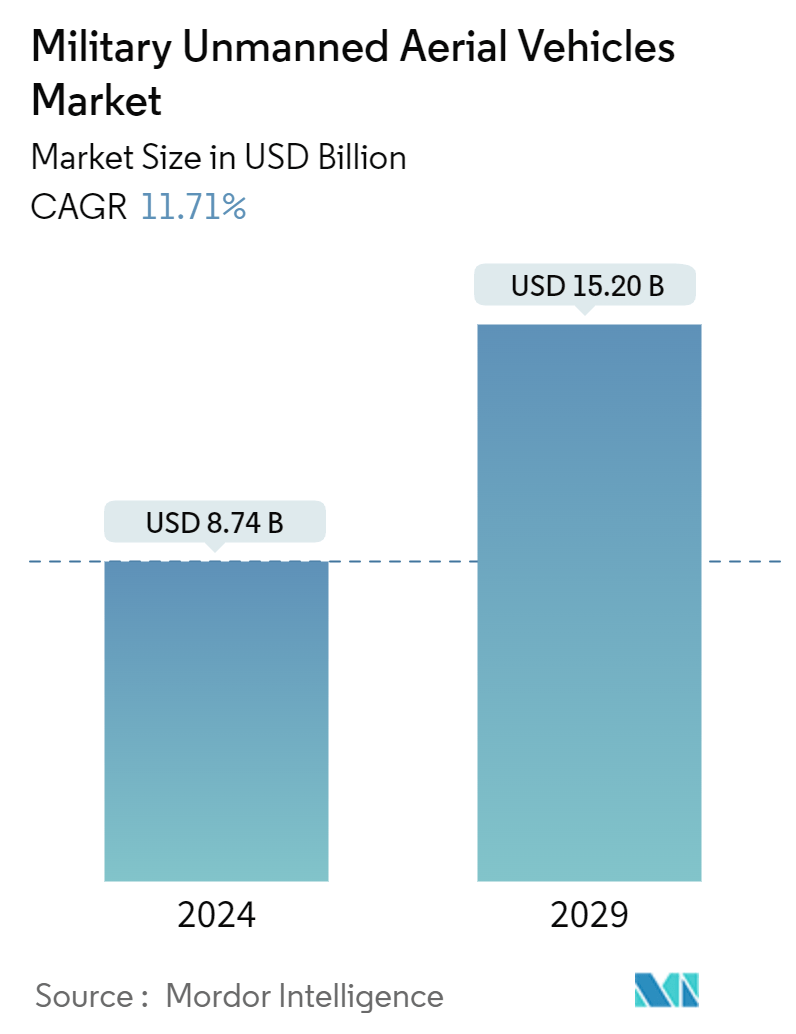
| Study Period | 2019 - 2029 |
| Market Size (2024) | USD 8.74 Billion |
| Market Size (2029) | USD 15.20 Billion |
| CAGR (2024 - 2029) | 11.71 % |
| Fastest Growing Market | Asia-Pacific |
| Largest Market | North America |
Major Players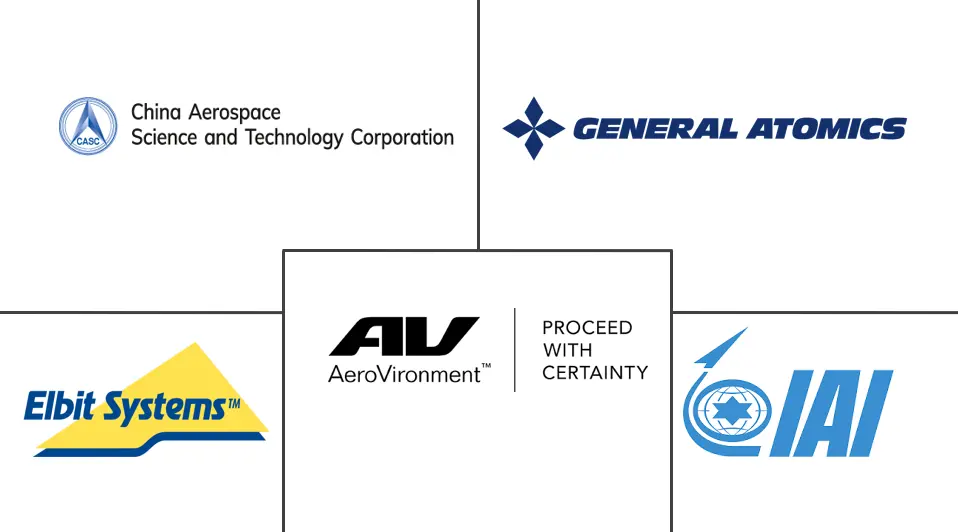
*Disclaimer: Major Players sorted in no particular order |
Military Unmanned Aerial Vehicles Market Analysis
The Military Unmanned Aerial Vehicles Market size is estimated at USD 8.74 billion in 2024, and is expected to reach USD 15.20 billion by 2029, growing at a CAGR of 11.71% during the forecast period (2024-2029).
The past decade has seen a significant surge in the adoption of military UAVs. End-users now deploy various models for tasks ranging from combat operations to surveillance, border patrolling, and inspections. Notably, advancements in next-gen military UAVs show no signs of slowing down. They are poised for accelerated growth. Real-time information is increasingly becoming the cornerstone of success in critical military missions. It equips warfighters, commanders, and troops with the necessary intelligence to safeguard themselves. As a result, there is a rising emphasis on superior tactical intelligence, surveillance, and reconnaissance, driving global armed forces to ramp up their UAV acquisitions.
While the drone market is growing, it faces significant hurdles. Safety concerns, airspace congestion, and stringent manufacturing standards set by many nations are key challenges. These standards not only impact local operations but also affect the global export of UAVs and their components. Despite these challenges, the drone industry is witnessing consolidation and attracting substantial investments. Industrial conglomerates, IT consultancies, and prominent industrialists are increasingly recognizing the potential of UAVs in defense. These factors and a growing awareness of UAV capabilities are set to propel the market studied during the forecast period.
Military Unmanned Aerial Vehicles Market Trends
Combat UAVs Expected to Exhibit Fastest Growth
- Combat drones have transitioned from optional assets to pivotal strategic tools for armed forces worldwide. The unmanned combat aerial vehicles market is witnessing a transformative shift, propelled by the rise of indigenous UCAV projects and the global influence of Chinese-made armed drones. Owning armed drone capabilities is swiftly becoming the standard. This shift is primarily driven by the operational and strategic advantages UCAVs offer. These benefits include cost-effectiveness, heightened reliability, and reduced operational risk. Moreover, UCAVs significantly enhance a nation's power projection through plausible deniability or by sharing these capabilities with allies and proxies.
- Escalating political tensions and the growing need for enhanced aerial strength amplify the demand for UCAVs. For instance, following Russia's 2022 invasion, the US Pentagon, alongside other organizations, bolstered Ukraine's drone capabilities as part of US aid. Ukraine, in turn, has also procured its fleet of small quadcopters and racing drones. Notably, the Royal United Services Institute reports that Ukraine loses around 10,000 drones monthly, highlighting the sheer volume required in modern warfare. Highlighting the global urgency, in August 2023, the Pentagon unveiled plans to ramp up production of cost-effective autonomous UAVs to counter China's rapid drone acquisitions. Echoing this sentiment, the Russian government directed state conglomerate Rostec to boost production of kamikaze KUB and Lancet combat drones. The KUB, armed with a 3 kg warhead, boasts a 30-minute flight duration and a top speed of 130 km/h. On the other hand, the Lancet UAV is equipped with a range of guidance systems, enabling it to strike targets up to 40 km away and carry payloads of up to 12 kilograms. These advancements are poised to significantly bolster the market during the forecast period.
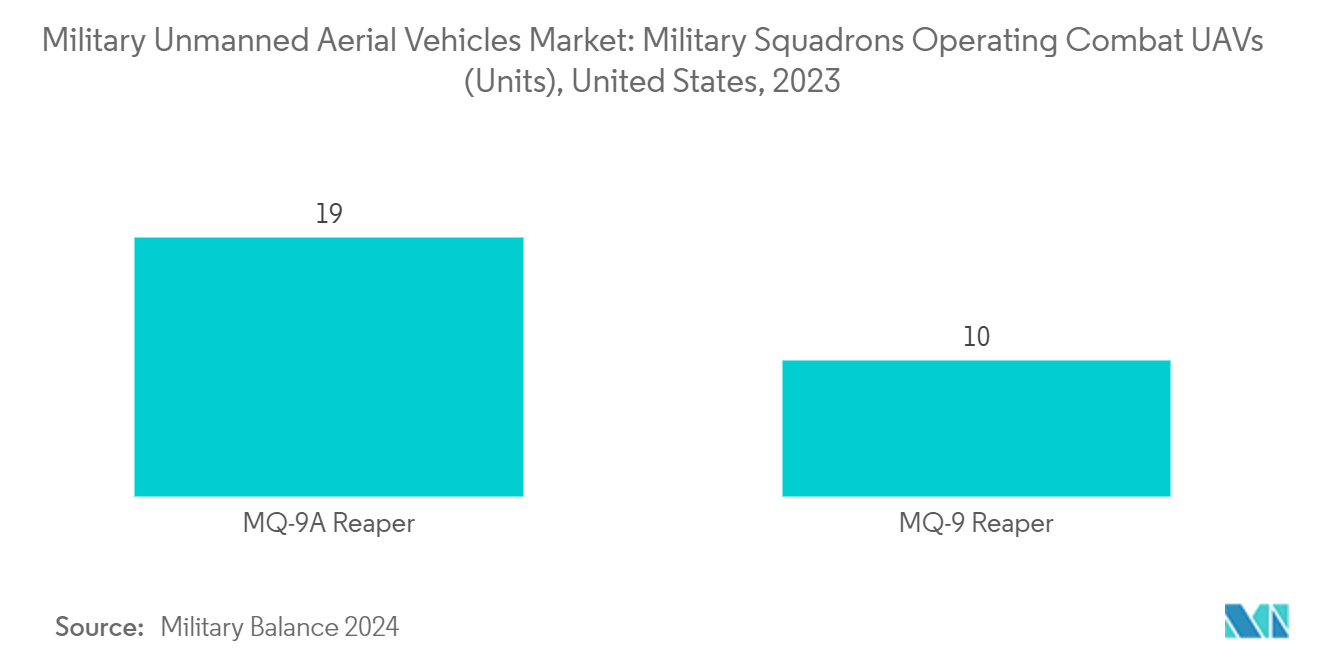
Asia-Pacific Expected to Exhibit Highest Growth
Throughout the forecast period, Asia-Pacific is set to take the lead in procurement initiatives and subsequent orders. Rising tensions surrounding the South China Sea dispute are prompting neighboring nations to enhance their military capabilities, with a strong focus on acquiring military UAVs. Countries like China, India, South Korea, and Japan consistently increase their defense budgets to bolster national security. This has sparked an evident arms race, with China and India notably escalating their defense expenditures. In 2023, these nations allocated substantial budgets: China at USD 296 billion, India at USD 83.6 billion, Japan at USD 50.2 billion, and South Korea at USD 47.9 billion.
Given their significant defense spending, these nations actively engage in various procurement and development programs, a trend expected to fuel market demand. For example, China is heavily investing in R&D, notably unveiling the KVD002 surveillance and precision strike UAV in September 2023. This UAV, equipped with two AR-1 air-to-surface missiles and reconnaissance devices, holds strategic importance, especially in potential conflicts over Taiwan. Similarly, in June 2023, India's Ministry of Defense approved the procurement of 31 MQ-9B UAVs from General Atomics, with an estimated cost of USD 3.07 billion, earmarked for the Indian Army, Air Force, and Navy.
Moreover, as outlined in strategic documents, Japan's Ministry of Defense is prioritizing investments in a diverse range of UAV platforms and capabilities. In alignment with this focus, in June 2023, Japan's MoD announced a planned investment of JPY1 trillion (USD 7.1 billion) over the next five years. This investment aims to replace some manned units in the Japan Self-Defense Forces with advanced unmanned systems, facilitating the early deployment of multiple unmanned assets. Such strategic moves are anticipated to further boost the market’s growth.
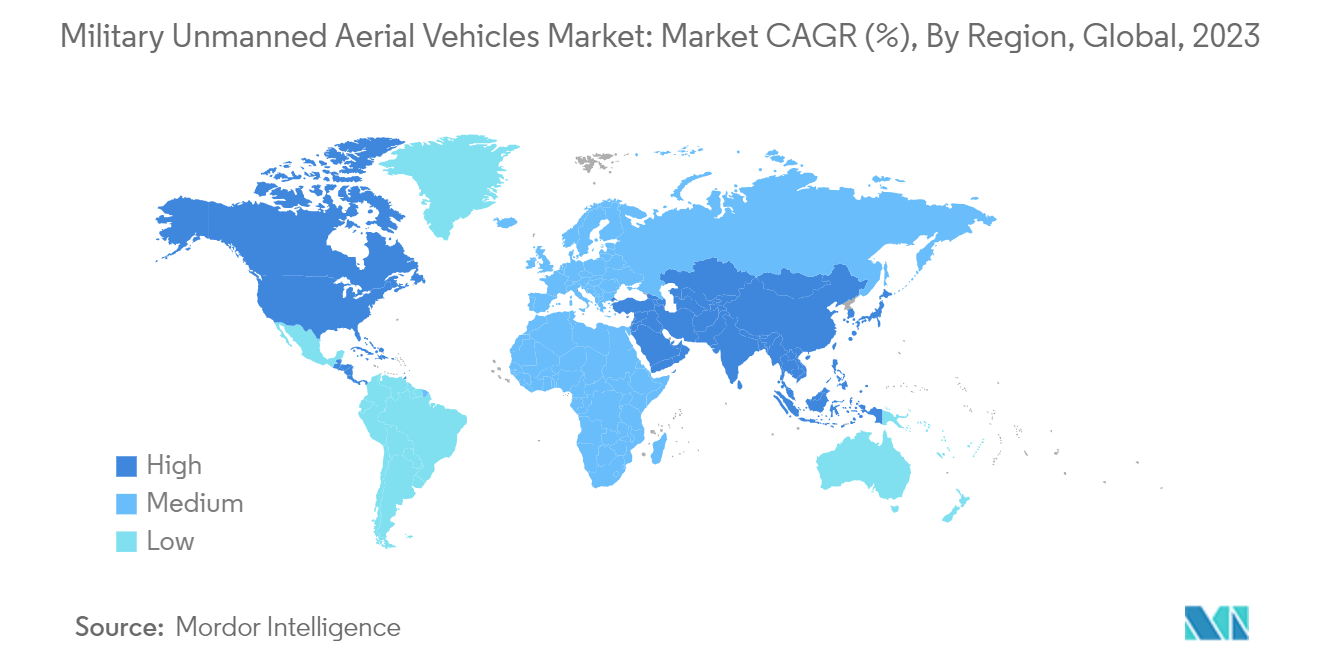
Military Unmanned Aerial Vehicles Industry Overview
The military UAV market is moderately fragmented due to the presence of many local players funded by the governments of the respective countries for the indigenous developments of UAVs for the military sector. Some prominent players in the military unmanned aerial vehicles market are Israel Aerospace Industries Ltd, General Atomics, China Aerospace Science Technology Corporation, AeroVironment Inc., and Elbit Systems Ltd.
Players in the UAV sector are bolstering their market shares through strategic investments and market expansions. The focus is on enhancing drone capabilities, with a notable emphasis on developing advanced payloads. These next-gen military UAVs are tailored for various missions, spanning combat and non-combat scenarios. Collaborations between industry players are on the rise, fostering technology exchange and streamlining development timelines.
Military Unmanned Aerial Vehicles Market Leaders
-
Israel Aerospace Industries Ltd.
-
General Atomics
-
China Aerospace Science, and Technology Corporation
-
AeroVironment, Inc.
-
Elbit Systems Ltd.
*Disclaimer: Major Players sorted in no particular order
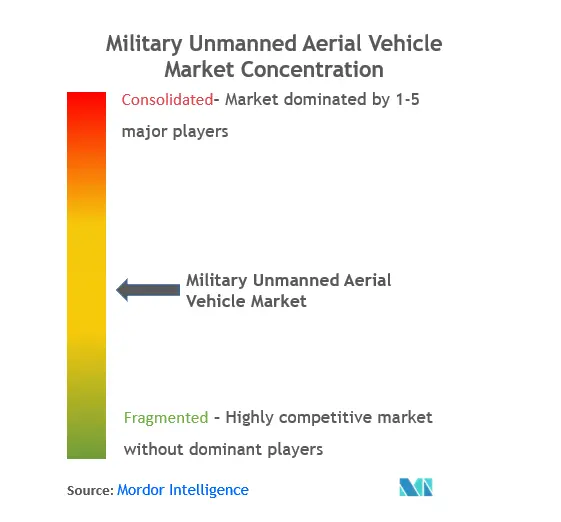
Military Unmanned Aerial Vehicles Market News
- October 2023: General Atomics Aeronautical Systems Inc. delivered more than twelve Protector RG Mk1 Combat UAVs to the Royal Air Force. These UAVs, a variant of GA-ASI’s MQ-9B, boast an impressive wingspan of nearly 80 feet and carry a payload of up to 500 pounds. This payload includes advanced weaponry like Paveway IV laser-guided bombs and Brimstone 3 missiles. The Royal Air Force plans to deploy these long-endurance UAVs for operational use in 2024.
- October 2023: Germany inked a USD 210 million deal with Rheinmetall for real-time reconnaissance UAVs. As part of this agreement, Rheinmetall is gearing up to supply the German Army with 13 Luna NG reconnaissance UAV systems, with deliveries scheduled to kick off in the second quarter of 2025.
Military Unmanned Aerial Vehicles Market Report - Table of Contents
1. INTRODUCTION
- 1.1 Study Assumptions
- 1.2 Scope of the Study
2. RESEARCH METHODOLOGY
3. EXECUTIVE SUMMARY
4. MARKET DYNAMICS
- 4.1 Market Overview
- 4.2 Market Drivers
- 4.3 Market Restraints
-
4.4 Industry Attractiveness - Porter's Five Forces Analysis
- 4.4.1 Threat of New Entrants
- 4.4.2 Bargaining Power of Buyers/Consumers
- 4.4.3 Bargaining Power of Suppliers
- 4.4.4 Threat of Substitute Products
- 4.4.5 Intensity of Competitive Rivalry
5. MARKET SEGMENTATION
-
5.1 By Type
- 5.1.1 Fixed-wing
- 5.1.2 VTOL
-
5.2 By Application
- 5.2.1 Combat
- 5.2.2 Non-combat
-
5.3 By Geography
- 5.3.1 North America
- 5.3.1.1 United States
- 5.3.1.2 Canada
- 5.3.2 Europe
- 5.3.2.1 United Kingdom
- 5.3.2.2 France
- 5.3.2.3 Germany
- 5.3.2.4 Russia
- 5.3.2.5 Rest of Europe
- 5.3.3 Asia-Pacific
- 5.3.3.1 China
- 5.3.3.2 Japan
- 5.3.3.3 India
- 5.3.3.4 South Korea
- 5.3.3.5 Rest of Asia-Pacific
- 5.3.4 Latin America
- 5.3.4.1 Brazil
- 5.3.4.2 Rest of Latin America
- 5.3.5 Middle East and Africa
- 5.3.5.1 United Arab Emirates
- 5.3.5.2 Saudi Arabia
- 5.3.5.3 Turkey
- 5.3.5.4 Rest of Middle East and Africa
6. COMPETITIVE LANDSCAPE
- 6.1 Vendor Market Share
-
6.2 Company Profiles
- 6.2.1 China Aerospace Science and Technology Corporation
- 6.2.2 Aeronautics Ltd
- 6.2.3 General Atomics
- 6.2.4 Baykar Tech
- 6.2.5 Elbit Systems Ltd
- 6.2.6 AeroVironment Inc.
- 6.2.7 Israel Aerospace Industries Ltd
- 6.2.8 The Boeing Company
- 6.2.9 Safran SA
- 6.2.10 Leonardo SpA
- 6.2.11 Textron Inc.
- 6.2.12 Lockheed Martin Corporation
- 6.2.13 Northrop Grumman Corporation
- 6.2.14 Saab AB
- *List Not Exhaustive
7. MARKET OPPORTUNITIES AND FUTURE TRENDS
** Subject To AvailablityMilitary Unmanned Aerial Vehicles Industry Segmentation
An unmanned aerial vehicle (UAV), commonly known as a drone, is a military aircraft that can operate autonomously, remotely, or via a blend of both methods. Outfitted with sensors, target designators, offensive ordnance, and electronic transmitters, these drones are designed primarily for engaging and neutralizing enemy targets.
The military unmanned aerial vehicles market is segmented by type, application, and geography. By type, the market is segmented into fixed-wing and VTOL. By application, the market is classified as combat and non-combat. The report also covers the market sizes and forecasts for the military unmanned aerial vehicles market in major countries across different regions. For each segment, the market size is provided in terms of value (USD).
| By Type | Fixed-wing | |
| VTOL | ||
| By Application | Combat | |
| Non-combat | ||
| By Geography | North America | United States |
| Canada | ||
| By Geography | Europe | United Kingdom |
| France | ||
| Germany | ||
| Russia | ||
| Rest of Europe | ||
| By Geography | Asia-Pacific | China |
| Japan | ||
| India | ||
| South Korea | ||
| Rest of Asia-Pacific | ||
| By Geography | Latin America | Brazil |
| Rest of Latin America | ||
| By Geography | Middle East and Africa | United Arab Emirates |
| Saudi Arabia | ||
| Turkey | ||
| Rest of Middle East and Africa |
Military Unmanned Aerial Vehicles Market Research FAQs
How big is the Military Unmanned Aerial Vehicles Market?
The Military Unmanned Aerial Vehicles Market size is expected to reach USD 8.74 billion in 2024 and grow at a CAGR of 11.71% to reach USD 15.20 billion by 2029.
What is the current Military Unmanned Aerial Vehicles Market size?
In 2024, the Military Unmanned Aerial Vehicles Market size is expected to reach USD 8.74 billion.
Who are the key players in Military Unmanned Aerial Vehicles Market?
Israel Aerospace Industries Ltd., General Atomics, China Aerospace Science, and Technology Corporation, AeroVironment, Inc. and Elbit Systems Ltd. are the major companies operating in the Military Unmanned Aerial Vehicles Market.
Which is the fastest growing region in Military Unmanned Aerial Vehicles Market?
Asia-Pacific is estimated to grow at the highest CAGR over the forecast period (2024-2029).
Which region has the biggest share in Military Unmanned Aerial Vehicles Market?
In 2024, the North America accounts for the largest market share in Military Unmanned Aerial Vehicles Market.
What years does this Military Unmanned Aerial Vehicles Market cover, and what was the market size in 2023?
In 2023, the Military Unmanned Aerial Vehicles Market size was estimated at USD 7.72 billion. The report covers the Military Unmanned Aerial Vehicles Market historical market size for years: 2019, 2020, 2021, 2022 and 2023. The report also forecasts the Military Unmanned Aerial Vehicles Market size for years: 2024, 2025, 2026, 2027, 2028 and 2029.
Military Unmanned Aerial Vehicles Industry Report
Statistics for the 2024 Military Unmanned Aerial Vehicles market share, size and revenue growth rate, created by Mordor Intelligence™ Industry Reports. Military Unmanned Aerial Vehicles analysis includes a market forecast outlook to 2029 and historical overview. Get a sample of this industry analysis as a free report PDF download.



